初二英语上册 lesson33的教学设计及反思一
新冀教版八年级上册英语 Lesson 33 教案
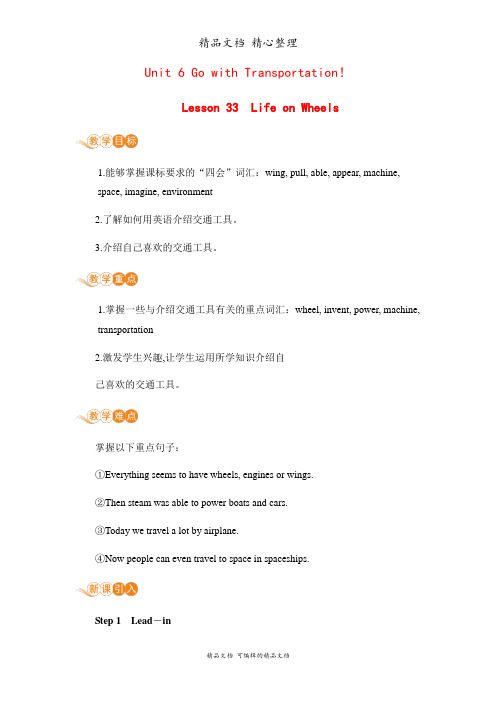
Unit 6 Go with Transportation!Lesson 33 Life on Wheels1.能够掌握课标要求的“四会”词汇:wing, pull, able, appear, machine, space, imagine, environment2.了解如何用英语介绍交通工具。
3.介绍自己喜欢的交通工具。
1.掌握一些与介绍交通工具有关的重点词汇:wheel, invent, power, machine, transportation2.激发学生兴趣,让学生运用所学知识介绍自己喜欢的交通工具。
掌握以下重点句子:①Everything seems to have wheels, engines or wings.②Then steam was able to power boats and cars.③Today we travel a lot by airplane.④Now people can even travel to space in spaceships.Step 1Lead-inLead in by showing some pictures of transportation. Let the students check in groups and ask questions about the subjects. Then present the results in front of the class.Questions:How can you travel to other places?Can we go to the moon?Step 2ListeningListen to the tape and know about the main points of the passage. At the same time, fill in the blanks with the words you hear:1.Everything seems to be getting________now.2.The world’s first train appeared about two________years ago.3.At present,many people travel by________.Finish the task in class in oral.Step 3ReadingRead the passage and answer the following questions:1.What do we have on our transportation?2.When did people invent the steam engine?3.What is Jeremy’s favourite type of transportation?Read the passage and finish the task in class in oral.Step 4PracticeMake a note to introduce your favourite type of transportation.Work in groups to finish the task.After a while,let some groups present their notes in front of the class.When the students are writing,the teacher walks around them to solve the problems that probably happen.Step 5 e to “Let’s Do It!”Listen to the tape and finish off Exercise 1 together.Read the lesson again and ask the students to do Exercise 2.1.Finish off Exercise 3 in “Let’s Do It!”.2.Write a note to introduce your favourite type of transportation.。
初中冀教版英语八年级上册【教学设计】Unit 6 Lesson 33

Unit 6 Go with transportationLesson 33 Life on wheels本课的教学内容是第六单元的第三课时, 主要内容涉及介绍交通工具。
在授课之前先让学生总结自己所知道的交通工具。
课上学生通过思考、讨论、交流和合作等方式,了解“车轮上的生活”的含义。
通过了解信息,丰富有关交通工具的知识, 掌握本课重点词汇。
【知识与能力目标】记忆单词wing, pull, able, appear, machine, space, imagine, environment短语be able to。
激发学生兴趣, 让学生运用所学知识介绍自己喜欢乘坐的交通工具。
【过程与方法目标】Reading and speaking【情感态度价值观目标】通过让学生介绍自己喜欢乘坐的交通工具来了解“车轮上的生活”。
【教学重点】掌握词汇wing, pull, able, appear, machine, space, imagine, environment, 接触词汇Jeremy, cart, skateboard, power, spaceship, 学习短语be able to等。
【教学难点】重点句子:Everything seems to have wheels, engines or wings. Then steam was able to power boats and cars. Boats have been around for thousands of years. Now people can even travel to space in spaceships图片,PPTStepⅠ. Lead inLeading in 【情景1】The teacher plays the song The Wheels on the Bus.Review the words and expressions learnt in the last lesson. Ask the students to think and talk about the questions:How many ways can you think of to use wheels?How can you get to the moon?[设计意图]通过歌曲激发学生课堂参与的积极性, 引出本课的话题。
冀教版八年级英语上册Lesson33优秀教学案例
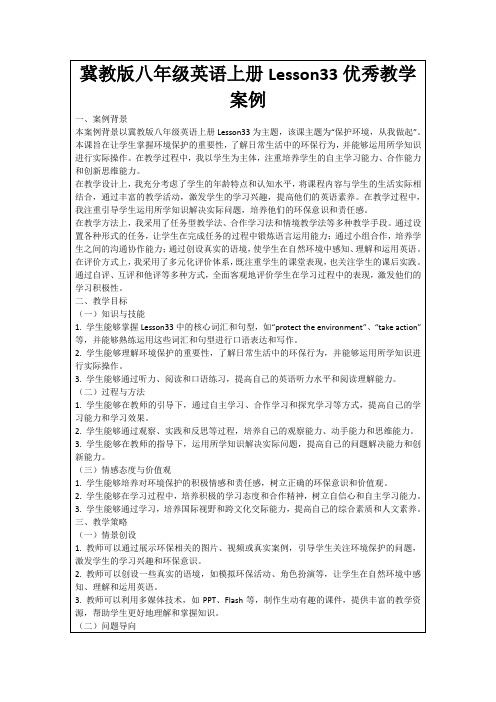
1.教师可以提出一些与环境保护相关的问题,引导学生进行思考和讨论,激发学生的问题解决能力和创新思维能力。
2.教师可以设计一些探究性任务,让学生通过观察、实践和反思等过程,培养自己的观察能力、动手能力和思维能力。
3.教师可以组织学生进行小组讨论或辩论,让学生在讨论中思考问题、解决问题,提高自己的沟通能力和团队合作能力。
(四)总结归纳
1.教师可以引导学生对所学知识进行总结和归纳,帮助学生巩固和记忆知识点。
2.教师可以设计一些总结性的问题或练习题,让学生通过回答问题或完成练习,检验自己的学习效果。
3.教师可以对本节课的主要内容和知识点进行简要回顾,强调重点和难点,为学生的复习提供参考。
(五)作业小结
1.教师可以布置一些与环境保护相关的作业,如写一篇关于环保的文章、制作一个环保宣传视频等,让学生在课后进行实际操作和应用。
在教学设计上,我充分考虑了学生的年龄特点和认知水平,将课程内容与学生的生活实际相结合,通过丰富的教学活动,激发学生的学习兴趣,提高他们的英语素养。在教学过程中,我注重引导学生运用所学知识解决实际问题,培养他们的环保意识和责任感。
在教学方法上,我采用了任务型教学法、合作学习法和情境教学法等多种教学手段。通过设置各种形式的任务,让学生在完成任务的过程中锻炼语言运用能力;通过小组合作,培养学生之间的沟通协作能力;通过创设真实的语境,使学生在自然环境中感知、理解和运用英语。
(二)讲授新知
1.教师可以根据教材内容,讲解环境保护的重要性、环保的基本概念和原则,以及日常生活中的环保行为等。
2.教师可以通过举例、讲解、互动等方式,解释和演示教材中的核心词汇和句型,如“protect the environment”、“take action”等,帮助学生理解和掌握。
Lesson33教案冀教版八年级英语上册

Lesson 33 Life on Wheels【教学目标】●知识目标重点词汇:pull, able, machine, space, imagine, environment重点短语:be able to, thousands of, be full of重点句型:1. Everything seems to have wheels, engines or wings.2. It’s good for my health and for the environment.3. What does it look like?●能力目标Enable students to describe life on wheels.【教学过程】Step 1: Lead inAsk the students to discuss the questions in “Think about it”.Step 2: ListeningLet the students listen to the tape carefully with the following questions:What does Jeremy talk about?Step 3: ReadingAsk the students to read the test silently. Then have discussion about the following questions in detail:When did people invent the steam engine?Step 4: Language points1.Hello,I’’m from the U.S.This is my report on transportation. 你好,我是杰里米。
我来自美国。
这是我关于交通工具的报告。
on 用于严肃This book is on 的或学术science. 这本书是关性的内容,较为正式于科学方面的。
冀教版英语八年级上册lesson33教学设计
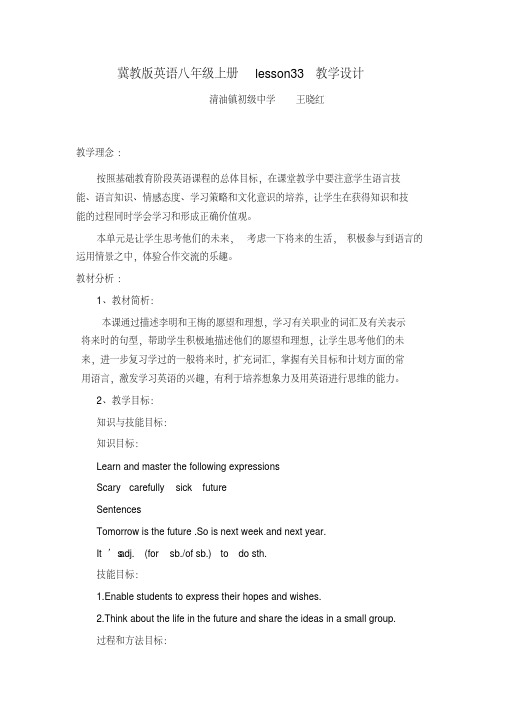
冀教版英语八年级上册lesson33教学设计清油镇初级中学王晓红教学理念:按照基础教育阶段英语课程的总体目标,在课堂教学中要注意学生语言技能、语言知识、情感态度、学习策略和文化意识的培养,让学生在获得知识和技能的过程同时学会学习和形成正确价值观。
本单元是让学生思考他们的未来,考虑一下将来的生活,积极参与到语言的运用情景之中,体验合作交流的乐趣。
教材分析:1、教材简析:本课通过描述李明和王梅的愿望和理想,学习有关职业的词汇及有关表示将来时的句型,帮助学生积极地描述他们的愿望和理想,让学生思考他们的未来,进一步复习学过的一般将来时,扩充词汇,掌握有关目标和计划方面的常用语言,激发学习英语的兴趣,有利于培养想象力及用英语进行思维的能力。
2、教学目标:知识与技能目标:知识目标:Learn and master the following expressions:Scary carefully sick futureSentences:Tomorrow is the future .So is next week and next year.It’s adj. (for sb./of sb.) to do sth.技能目标:1.Enable students to express their hopes and wishes.2.Think about the life in the future and share the ideas in a small group.过程和方法目标:1.Enable students to express their hopes and wishes2.Help the students to learn to predict their future life and their jobs.情感态度价值观目标:Set up your ambition for your future.教学重点:1、Some words and expressions about the future.2、Predict their future life and jobs and the future tense.教学难点:1、熟练运用“so+助动词/情态动词/be 动词+主语”的倒装句。
Lesson 33 Let’s Go to the Zoo教学案例及教学反思
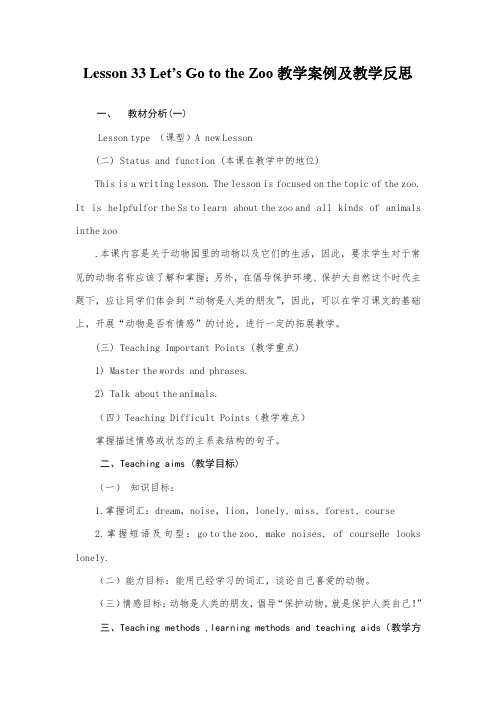
Lesson 33Let’s Go to the Zoo教学案例及教学反思一、教材分析(一)Lesson type (课型)A new Lesson(二) Status and function (本课在教学中的地位)This is a writing lesson.The lesson is focused on the topic of the zoo. It is helpfulfor the Ss to learn about the zoo and all kinds of animals inthe zoo.本课内容是关于动物园里的动物以及它们的生活,因此,要求学生对于常见的动物名称应该了解和掌握;另外,在倡导保护环境、保护大自然这个时代主题下,应让同学们体会到“动物是人类的朋友”,因此,可以在学习课文的基础上,开展“动物是否有情感”的讨论,进行一定的拓展教学。
(三) Teaching Important Points (教学重点)1) Master the words and phrases.2) Talk about the animals.(四)Teaching Difficult Points(教学难点)掌握描述情感或状态的主系表结构的句子。
二、Teaching aims (教学目标)(一)知识目标:1.掌握词汇:dream,noise,lion,lonely, miss, forest, course2.掌握短语及句型:go to the zoo, make noises, of courseHe looks lonely.(二)能力目标:能用已经学习的词汇,谈论自己喜爱的动物。
(三)情感目标:动物是人类的朋友,倡导“保护动物,就是保护人类自己!”三、Teaching methods ,learning methods and teaching aids(教学方法及手段)(一)Teaching methods1. Multi-media teaching. It can help the students be interested in the lessonand learn the lesson happily and easily. 2. Encouragement and praise.3. “Task-based” teaching method.“Task-based”language teaching has been one of the most important foreignteaching approaches during these years .The New English Curriclesum requiresteachers to use it .It’s an effective and advanced teaching approach .It’s widely usedin many different countries.(二)Learning methodsAs an English teacher, your duty is not only to teach the students some Englishknowledge, but also to raise their skills of learning and using English.1. Teach Ss how to be successful language learners.2. Teach Ss how to describe something3. Get the Ss to form good learning habits. Such as cooperation and com-petition .Students cooperate and compete with each other by working in groups.(三)Teaching Aids1. Multi-media computer1. CAI 课件2. Pictures of animals四、Analysis of the students (学情分析)The students are in Grade Seven now, and they have some interests of learningand speaking English, they are willing to cooperate and compete with others in class,especially most of the students are interestedinthe animals. I think it’s easy forthem to learn this lesson and they will take an active part in the activities in class五、Teaching Procedures (教学过程)Step One: Lead in (3 minutes)1. Express greeting each other2. Play guessing word games to build students’ vocabulary.(设计意图:上课伊始,我就利用游戏与竞赛的形式,让学生进行抢答拼读动物单词,抓住学生好胜的心理,增强学生的竞争意识,也为后面的教学奠定了基础,同时使学生不由自主的进入了一个英语学习的佳境。
冀教版八年级英语上册教案Unit 6 Lesson 33
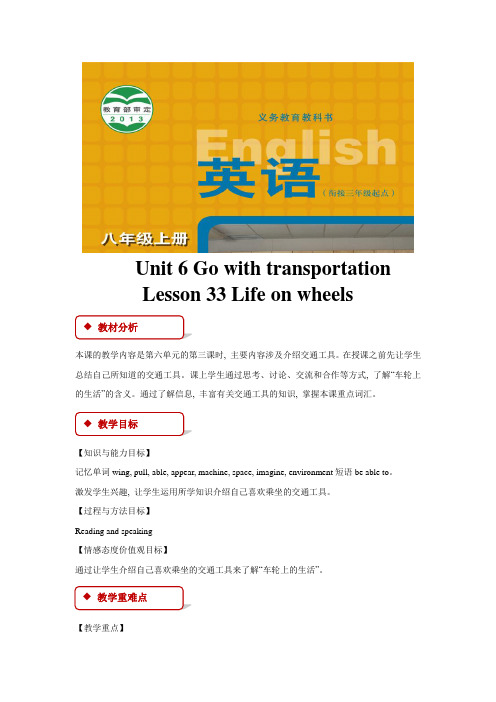
Unit 6 Go with transportationLesson 33 Life on wheels本课的教学内容是第六单元的第三课时, 主要内容涉及介绍交通工具。
在授课之前先让学生总结自己所知道的交通工具。
课上学生通过思考、讨论、交流和合作等方式,了解“车轮上的生活”的含义。
通过了解信息, 丰富有关交通工具的知识, 掌握本课重点词汇。
【知识与能力目标】记忆单词wing, pull, able, appear, machine, space, imagine, environment 短语be able to 。
激发学生兴趣, 让学生运用所学知识介绍自己喜欢乘坐的交通工具。
【过程与方法目标】Reading and speaking【情感态度价值观目标】通过让学生介绍自己喜欢乘坐的交通工具来了解“车轮上的生活”。
【教学重点】掌握词汇wing, pull, able, appear, machine, space, imagine, environment, 接触词汇Jeremy, cart, skateboard, power, spaceship, 学习短语be able to等。
【教学难点】重点句子:Everything seems to have wheels, engines or wings. Then steam was able to power boats and cars. Boats have been around for thousands of years. Now people can even travel to space in spaceships图片,PPTStepⅠ. Lead inLeading in 【情景1】The teacher plays the song The Wheels on the Bus.Review the words and expressions learnt in the last lesson. Ask the students to think and talk about the questions:How many ways can you think of to use wheels?How can you get to the moon?[设计意图]通过歌曲激发学生课堂参与的积极性, 引出本课的话题。
新编冀教版八年级英语上册 Lesson 33【优质教案】

Lesson 33 Life on WheelsLearning aims:1. Learn the history of the cars.2. Describe one type of transportation in the future.Learning important and difficult points:1. Learn about the Danny wheels.2. Imagine what types of transportation will be like from one hundred years now.Learning tools:audiotape, flashcards, picturesLearning steps:Step 1. TalkingLet the students talk about something about the planes and the cars. What do they know about the planes and the cars? If they know, let them say their details.Step 2. AskingAsk the students to talk about the picture in the text. What do they think about this?Step 3. Let’s listen to the tape and answer the following questions:Step 4. ReadingRead the text and check the answers. Then let the students read it loudly in class. After a while, ask the students read the text in roles.Step 5. ActionLet students act out the dialogue. They can take a circle for Danny’s wheel.Step 6. Ask some students to make sentences with the following phrases: At that time, need to, present, you’d better not.At that time, I was a little girl.You need to wear warm clothes in cold winter.Present your invention to the class.You’d better say it again.Step 7. HomeworkWrite a letter to your friend in English.。
Lesson33+教学设计 冀教版八年级英语上册+

Lesson 33 Life on Wheels教学设计基本信息课题Lesson 33 Life on Wheels课型Reading,speaking 主备人课时One备课时间2023.11.16 授课时间教学目标1.掌握本课单词,短语及句式wing,pull,cart,able,power,appear,machine,space,spaceship,imagine,environment,be able to。
2.学生能介绍交通发展史并会表达自己喜欢乘坐的交通方式。
1.激发学生学习兴趣,并尽可能的选择低碳出行,安全第一。
教学重难点重点掌握本课的核心词汇及表达。
难点介绍交通发展史并会表达自己喜欢乘坐的交通方式。
教材分析一、语篇研读What:本课语篇内容是以独白的形式介绍了交通的发展史。
文章写到蒸汽机的发明使人们过上了轮子上的生活。
先介绍了蒸汽机火车,然后轮船和汽车,之后是飞机和火箭。
人们的生活随着交通工具的发展越来越方便和快捷。
但作者最喜欢的交通方式是自行车,因为它健康环保。
Why:文章介绍交通的发展史可以帮助学生更加清晰的了解交通的发展过程,通过本课的听录音、自主阅读、小组探究合作等活动,给学生提供充足的思考想象的空间,同时也培养了学生的综合运用语言能力,激发了学生的创造力,并为本单元关于描述或介绍某一个交通方式的读写活动奠定了基础。
How:本课的语篇内容是介绍交通的发展史,主要内容为介绍不同交通工具的发明信息。
文章中运用了有关交通发展的词汇,如wheels,machine,spaceship 等。
文章使用了一般过去时、现在完成时和一般现在时准确传达信息,并运用动词不定时做宾语语法知识。
教具准备PPT, Textbook, card, paper,教学过程Step1 Lead-inArouse Ss’ interest in the topic, ask the students to enjoy a song about “wheels on the bus” and try to sing along. And ask some questions:Which transportation has wheels?How many ways can you think of to use wheels? Step2 PresentationTeacher shows some pictures, and teaches the new words in this lesson. Let the class read aloud and try to make sentences with them.Step3lListeningPlay the tape and ask the students to listen to a passage and choose the right answers.( No.1 in Let’s Do It.)Step 4 Reading1. Ask the students to read the lesson and finish No.2 in Let’s Do It.2. Read the lesson again, and answer the questions:1). How did people travel long ago?2). When did people invent the steam engine and trains? 3). What can the steam engine do?4). When did people begin to make flying machines? 5). How can people travel to the space now?Step5 SpeakingAccording to the answers above, ask the students to tell the development of the transportation.Step 6 Watching, thinking and speakingAsk the students to watch a video about the history of the transportation, and ask : 1.Cars are really important, yes? Why?2.Are cars really good enough? What if too many cars are on the road?GO LONGGO LONG O L O N GA G OG O L O N GA G O(Traffic jam, pollution, shortage of energy…)3. Teacher:My favourite type of transportation is the bicycle. It is fun to ride a bike.and it is good for my health and for the environment.what about you? What ‘s your favourite type of transportation ? Student A : I like ...,because...Student B:My favourite type of transportation is... ...4. What should we do? Can you imagine future transportation?Step 7 Drawing and tellingLet the students draw pictures about future transportation, they can write some sentences with the pictures, then present their pictures in the front.布置作业1. B etter your pictures and share your ideas with your classmates.2. Write a short passage about your future transportation.(选做)板书设计 Lesson 33 Life on Wheels教学反思GO LONGGO LONG O L O N GA G OG O L O N GA G O。
教学设计冀教版英语八年级上册Lesson33
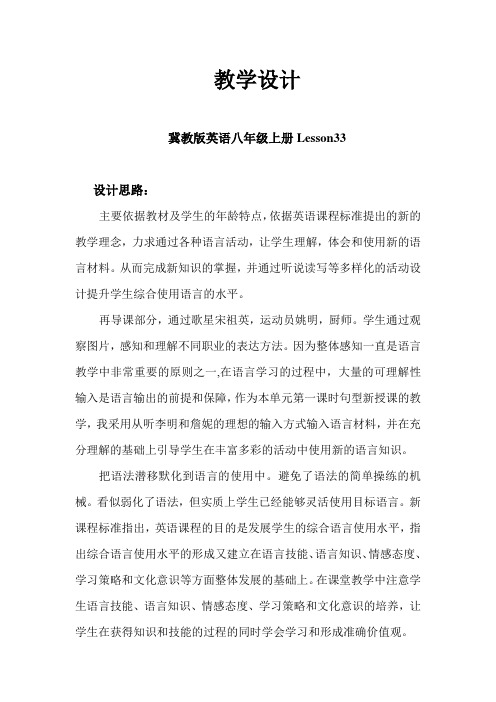
教学设计冀教版英语八年级上册Lesson33设计思路:主要依据教材及学生的年龄特点,依据英语课程标准提出的新的教学理念,力求通过各种语言活动,让学生理解,体会和使用新的语言材料。
从而完成新知识的掌握,并通过听说读写等多样化的活动设计提升学生综合使用语言的水平。
再导课部分,通过歌星宋祖英,运动员姚明,厨师。
学生通过观察图片,感知和理解不同职业的表达方法。
因为整体感知一直是语言教学中非常重要的原则之一,在语言学习的过程中,大量的可理解性输入是语言输出的前提和保障,作为本单元第一课时句型新授课的教学,我采用从听李明和詹妮的理想的输入方式输入语言材料,并在充分理解的基础上引导学生在丰富多彩的活动中使用新的语言知识。
把语法潜移默化到语言的使用中。
避免了语法的简单操练的机械。
看似弱化了语法,但实质上学生已经能够灵活使用目标语言。
新课程标准指出,英语课程的目的是发展学生的综合语言使用水平,指出综合语言使用水平的形成又建立在语言技能、语言知识、情感态度、学习策略和文化意识等方面整体发展的基础上。
在课堂教学中注意学生语言技能、语言知识、情感态度、学习策略和文化意识的培养,让学生在获得知识和技能的过程的同时学会学习和形成准确价值观。
本单元是让学生思考他们的未来,考虑一下将来的生活,积极参与到语言的使用情景之中,体验合作交流的乐趣。
在本节课的开始,我首先通过课件的演示和师生谈话自然地导入本课,然后带动学生讨论,从而为他们提供了自我充分变现和主动表达的机会。
新课标倡导任务型的教学模式,让学生在教师的指导下,通过感知,体验,实践,参与和合作的教学模式逐步达到教学目标的要求,这就要求教师在教学目标的指导下实行教学,设置一个个可行,有效的任务,并是其通过参与,合作等方式来完成任务,一伙的情感体验,发展自主学习的水平。
在本课的教学中我设置了猜未来的职业,谈及讨论未来的感受两个任务型活动。
教材简析:本课通过描述李明和王梅的愿望和理想,学习如何问职业的句型及相关表示将来时的句型和相关职业的词汇。
冀教版八年级英语上册Lesson33LifeonWheels教学设计
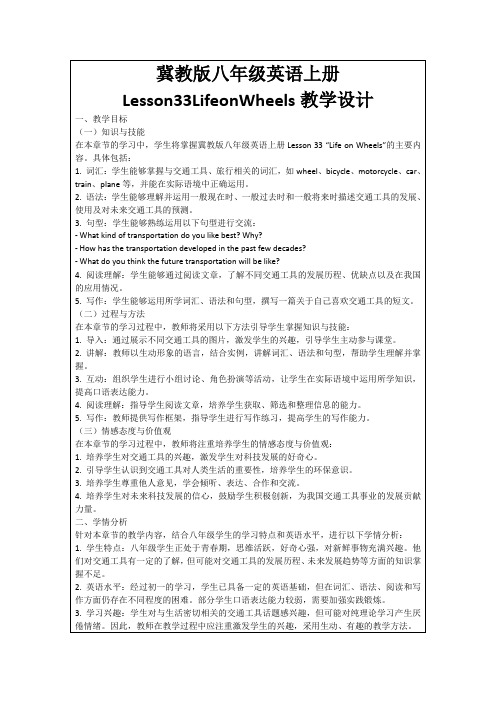
4.阅读理解:学生能够通过阅读文章,了解不同交通工具的发展历程、优缺点以及在我国的应用情况。
5.写作:学生能够运用所学词汇、语法和句型,撰写一篇关于自己喜欢交通工具的短文。
(二)过程与方法
2.语法:学生能够理解并运用一般现在时、一般过去时和一般将来时描述交通工具的发展、使用及对未来交通工具的预测。
3.句型:学生能够熟练运用以下句型进行交流:
- What kind of transportation do you like best? Why?
- How has the transportation developed in the past few decades?
作业布置要求:
1.作业量适中,确保学生能在规定时间内完成。
2.作业难度分层,满足不同层次学生的学习需求。
3.教师及时批改作业,给予学生反馈,指导他们改进学习方法。
4.鼓励学生互相交流、讨论,共同提高。
难点:正确运用时态进行描述和表达。
3.阅读理解:学生需要通过阅读文章,了解交通工具的发展历程、优缺点以及在我国的应用情况。
难点:快速获取关键信息,提高阅读理解能力。
4.写作:学生需运用所学词汇、语法和句型,撰写一篇关于交通工具的短文。
难点:合理安排文章结构,清晰表达观点。
(二)教学设想
1.创设情境:通过展示交通工具的图片和视频,创设生动、直观的教学情境,激发学生的学习兴趣。
在本章节的学习过程中,教师将采用以下方法引导学生掌握知识与技能:
1.导入:通过展示不同交通工具的图片,激发学生的兴趣,引导学生主动参与课堂。
lesson33HowCanYouGo河北版八年级上英语教案
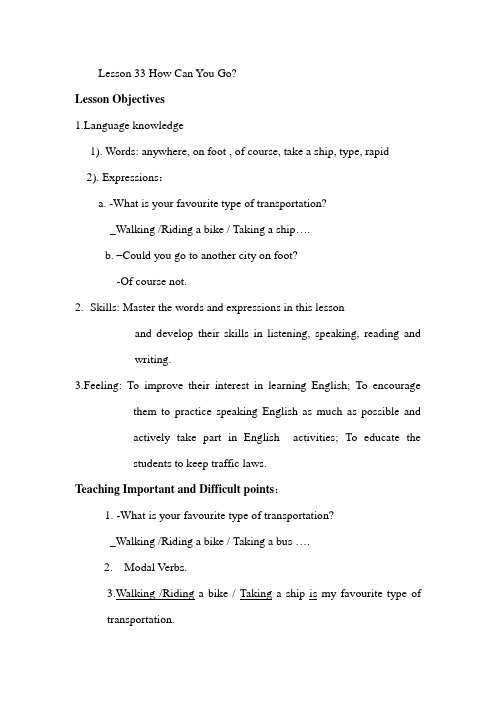
Lesson 33 How Can You Go?Lesson Objectivesnguage knowledge1). Words: anywhere, on foot , of course, take a ship, type, rapid2). Expressions:a. -What is your favourite type of transportation?_Walking /Riding a bike / Taking a ship….b. –Could you go to another city on foot?-Of course not.2.Skills: Master the words and expressions in this lessonand develop their skills in listening, speaking, reading andwriting.3.Feeling: To improve their interest in learning English; To encouragethem to practice speaking English as much as possible andactively take part in English activities; To educate thestudents to keep traffic laws.Teaching Important and Difficult points:1. -What is your favourite type of transportation?_Walking /Riding a bike / Taking a bus ….2. Modal Verbs.3.Walking /Riding a bike / Taking a ship is my favourite type oftransportation.Teaching Recourses : audiotape, flashcards and picturesTeaching method:Six-step teaching method and co-operative learning wayTeaching time: one periodLesson Structure一Warming-upAsk the Ss to listen to a song and then tell the class the names of the things they hear such as cars, buses, trains and so on. Then show some pictures to teach “transportation” and “type”.二Reading1.Watch the cartoon I made with the questions.1).What is Danny’s favourite type of transportation?2). What does Jenny like best?2. Follow the tape.三.Ask and explain1.Ask the Ss to read the text and try to answer some questions on thetext. They can have a discussion to answer them.1).What does “take a train” mean in English?2). What does “take” mean in the sentence“But that would take a long time”?3). Which is more rapid, a ship or a plane?4). Why couldn’t Brain take a train to Londonto visit his parents?5). In the sentence “Could you go to another cityon foot” , can we say “can” instead of “could”?2. Ask if they have anything they don’t understand.四Practice1.Ask Ss to read the text in a group and try to present the dialogue.2. Play a game: Show some pictures of types of transportation. OneS does the actions and the others try to guess what type oftransportation it is. They shouldn’t use “car” or “by car” but“taking a car”.3.Fill in a form.How can I go to Beijing? (Compare different types oftransportation.)4. Show some signs of traffic and educate them to keep trafficlaws.五Exercises.六.Summary.七Homework.1). Write a passage: My favourite transportation.2). Draw a picture of your future transportation.(You can imagine and be creative!)Lesson 33 How can you go?评课稿:本课是河北版八年级下第五单元第一课.课文分为两部分:Can you take a plane to the bakery? 和Let’s do it.我主要采用了六环节教学模式和小组合作学习方式.还采用了多媒体教学辅助手段,使英语教学变得直观生动有趣.充分激发学生的学习兴趣,调动学生的学习积极性和主动性,强化了学生对知识的记忆,巩固. 在教学活动中,突出了学生的主体地位,把时间和机会都留给了学生。
Lesson33学案冀教版八年级英语上册

Lesson 33 Life on Wheels【学习目标】1熟练掌握本课词汇、短语、句型。
2.掌握所有知识点。
【重点难点】单词:Jeremy [ˈdʒerəmi] 杰里米(人名)_______ [wɪŋ] n. 翅膀__________ [pʊl] n. 拉;拖________[kɑ:t] n.手推车_________[ˈskeɪtbɔ:d] n. 滑板___________[ˈeɪbl ] n. 能,能够(用作情态动词)__________ [ˈpaʊə] v. 驱动;推动________[əˈpɪr] v. 出现;呈现;来到_________ [məˈʃi:n] n.机器;机械_________[ speɪs] n. 太空;空间;距离____________[ˈspeɪsʃɪp]n.宇宙飞船__________[ɪˈmædʒɪn]v. 想象,想到____________ [ɪn ˈvaɪrənmənt] n.环境短语:1,……的开端2, 能够,胜任3, 数以千计的4, 两百年前________________________5, 一百多年_______________________6, 充满……的7, 似乎去做某事8, 开始做某事9, 乘坐飞机10, 对……有益【导学流程】一) 了解感知Task 1: ★Read the passage carefully and check the pronunciation of the words .Task 2: ★Listen to the passage and check the pronunciation of the words and underline the phrases.二) 深入学习Task 3: ★Let’s Do It (1)(2)(3)Task4: ★translation between English and Chinese.三)迁移运用Task 5: ★plete the sentences according to the examples.1.The steam was able to power boats and cars.本句使用了be able to的固定搭配。
冀教初中英语八上《Lesson 33 Life on Wheels》word教案 (1)

Ask the studentsto do Let’s Do It Ex.2 and write down the answers. Then check the answers together.
(Let’s Do It! Ex. 1. )
Step 6 Consolidation(5 minutes)
According to the lesson, what have you learned?
Step 7 Class closing(3 minutes)
1. Pair work
Imagine the future transportation. Then make up a dialogue in pairs.
Step2 New Concepts
1. Leading in(1 minute)
T: This world is always moving. Everything seems to have wheels. Now our life is on wheels. 板书本课课题Lesson 33 Life on Wheels.
1. According to Jeremy, what does everything seem to have?
2. What did horses do long ago?
3. What did people do over 100 years ago?
4. What is space? Can you travel to space with an airplane?
冀教版八年级英语上册Lesson33LifeonWheels优质教案(2)

Lesson 33 Life on Wheels一、教材分析1. 教学目标●语言知识掌握词汇:wing, pull, able, appear, machine, space, imagine, environment, be able to●语言技能理解并能灵活运用书中的重点单词、短语。
●情感态度培养学生英语阅读能力,保持学习英语的浓厚兴趣,提高学生之间的合作能力。
●教学策略学生通过思考、讨论、交流和合作等方式,了解“车轮上的生活”。
在教学过程中借助多媒体,提高课堂效率。
2. 教学重点通过了解信息,丰富有关交通工具的知识,掌握本课重点词汇。
3. 教学难点掌握不定式用法。
二、教学准备多媒体课件、配套教学光盘三、教学步骤Step 1 Class opening(3 minutes)1. Greetings.2. Sing a song The Wheels on the Bus.这首英文儿歌不仅是进入课堂状态的一个热身,而且为本课学习做了铺垫。
Step2 New Concepts1. Leading in(1 minute)T: This world is always moving. Everything seems to have wheels. Now our life is on wheels. 板书本课课题Lesson 33 Life on Wheels.2. Discussion(2 minutes)Discuss: How many ways can you think of to use wheels? 引导学生自由讨论、发言,然后出示图片。
3. Read the text and fill in the blanks (4 minutes)T: Jeremy wrote a report. Please read it carefully and quickly. Fill in the blanks.1. This is Jeremy’s report on t_______________.2. Cars make the U.S. a nation on w___________.3. Now people can even travel to space in s_______________.4. Riding a bike is good for our health and the e_______________.Ask the students to do Let’s Do It Ex.2 and write down the answers. Then check the answers together.4. Read the text again and answer the questions.(5 minutes)T: Now let’s read Jeremy’s report again and we will know more about it. Please try to answer the questions in 5 minutes.1. According to Jeremy, what does everything seem to have?2. What did horses do long ago?3. What did people do over 100 years ago?4. What is space? Can you travel to space with an airplane?在此环节,要限定学生阅读及做题时间,并根据问题的难易程度,请同学板书答案。
(新)冀教版八年级上册 Lesson 33(优秀课)教案

初中英语冀教版八年级上册第六单元Lesson 33 Life on Wheels一、教材分析1. 教学目标●语言知识掌握词汇:wing, pull, able, appear, machine, space, imagine, environment, be able to●语言技能理解并能灵活运用书中的重点单词、短语。
●情感态度培养学生英语阅读能力,保持学习英语的浓厚兴趣,提高学生之间的合作能力。
●教学策略学生通过思考、讨论、交流和合作等方式,了解“车轮上的生活〞。
在教学过程中借助多媒体,提高课堂效率。
2. 教学重点通过了解信息,丰富有关交通工具的知识,掌握本课重点词汇。
3. 教学难点掌握不定式用法。
二、教学准备多媒体课件、配套教学光盘三、教学步骤Step 1 Class opening〔3 minutes〕1. Greetings.2. Sing a song The Wheels on the Bus.这首英文儿歌不仅是进入课堂状态的一个热身,而且为本课学习做了铺垫。
Step2 New Concepts1. Leading in〔1 minute〕T: This world is always moving. Everything seems to have wheels. Now our life is on wheels. 板书本课课题Lesson 33 Life on Wheels.2. Discussion〔2 minutes〕Discuss: How many ways can you think of to use wheels? 引导学生自由讨论、发言,然后出示图片。
3. Read the text and fill in the blanks 〔4 minutes〕T: Jeremy wrote a report. Please read it carefully and quickly. Fill in the blanks.1. This is Jeremy’s report on t_______________.2. Cars make the U.S. a nation on w___________.3. Now people can even travel to space in s_______________.4. Riding a bike is good for our health and the e_______________.Ask the students to do Let’s Do It Ex.2 and write down the answers. Then check the answers together.4. Read the text again and answer the questions.〔5 minutes〕T: Now let’s read Jeremy’s report again and we will know more about it. Please try to answer the questions in 5 minutes.1. According to Jeremy, what does everything seem to have?2. What did horses do long ago?3. What did people do over 100 years ago?4. What is space? Can you travel to space with an airplane?在此环节,要限定学生阅读及做题时间,并根据问题的难易程度,请同学板书答案。
初二英语上册lesson33的教学设计及反思一
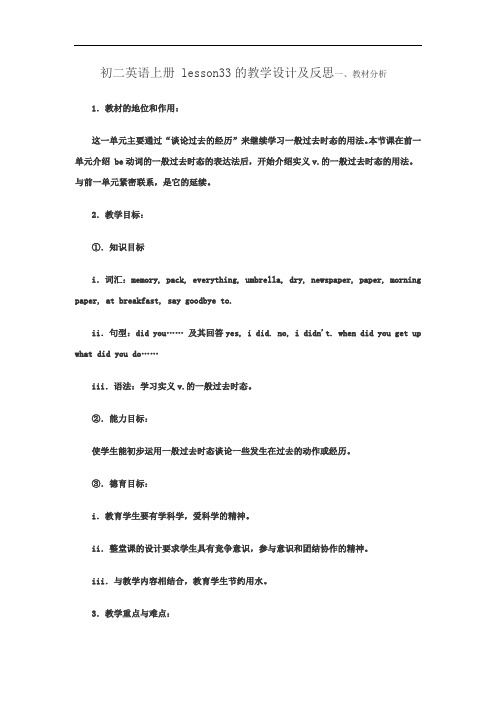
初二英语上册 lesson33的教学设计及反思一、教材分析1.教材的地位和作用:这一单元主要通过“谈论过去的经历”来继续学习一般过去时态的用法。
本节课在前一单元介绍 be动词的一般过去时态的表达法后,开始介绍实义v.的一般过去时态的用法。
与前一单元紧密联系,是它的延续。
2.教学目标:①.知识目标i.词汇:memory, pack, everything, umbrella, dry, newspaper, paper, morning paper, at breakfast, say goodbye to.ii.句型:did you…… 及其回答yes, i did. no, i didn't. when did you get up what did you do……iii.语法:学习实义v.的一般过去时态。
②.能力目标:使学生能初步运用一般过去时态谈论一些发生在过去的动作或经历。
③.德育目标:i.教育学生要有学科学,爱科学的精神。
ii.整堂课的设计要求学生具有竞争意识,参与意识和团结协作的精神。
iii.与教学内容相结合,教育学生节约用水。
3.教学重点与难点:①.教学重点:i.实义v.的过去式的变化。
ii.实义v.的一般过去时态,它的陈述句,疑问句及其应答,以及在具体情景中的交际运用。
②.教学难点:一般过去时态的实际运用。
二、教学方法与手段:主要运用了情景教学法和任务型教学法。
同时整堂课都串插竞赛机制,鼓励学生小组团结合作。
在尊重学生个性发展,面向全体学生的基础上,由浅入深,由已知到未知,循序渐进地深化教学内容。
展开以教师为主导,以学生为主体的师生双边活动。
另外,为了培养学生辨别、理解、分析、运用能力,教学中充分运用了多媒体辅助教学的手段,增强了教学的直观性和趣味性,加大了课堂密度,提高了教学效果。
三、教学设计:step 1.复习阶段:教学思路:1.首先以一首美丽轻快的英文儿歌带领学生进入课堂,以激发学生的学习爱好,营造轻松的英语学习氛围。
Lesson33 教学反思
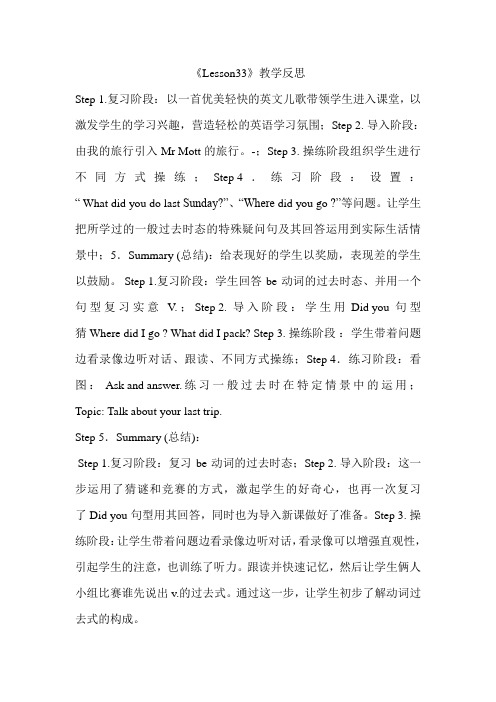
《Lesson33》教学反思
Step 1.复习阶段:以一首优美轻快的英文儿歌带领学生进入课堂,以激发学生的学习兴趣,营造轻松的英语学习氛围;Step 2. 导入阶段:由我的旅行引入 Mr Mott 的旅行。
-;Step 3. 操练阶段组织学生进行不同方式操练;Step 4.练习阶段:设置:“ What did you do last Sunday?”、“Where did you go ?”等问题。
让学生把所学过的一般过去时态的特殊疑问句及其回答运用到实际生活情景中;5.Summary (总结):给表现好的学生以奖励,表现差的学生以鼓励。
Step 1.复习阶段:学生回答be动词的过去时态、并用一个句型复习实意V.;Step 2. 导入阶段:学生用 Did you 句型猜 Where did I go ? What did I pack? Step 3. 操练阶段:学生带着问题边看录像边听对话、跟读、不同方式操练;Step 4.练习阶段:看图: Ask and answer.练习一般过去时在特定情景中的运用;Topic: Talk about your last trip.
Step 5.Summary (总结):
Step 1.复习阶段:复习be动词的过去时态;Step 2. 导入阶段:这一步运用了猜谜和竞赛的方式,激起学生的好奇心,也再一次复习了 Did you 句型用其回答,同时也为导入新课做好了准备。
Step 3. 操练阶段:让学生带着问题边看录像边听对话,看录像可以增强直观性,引起学生的注意,也训练了听力。
跟读并快速记忆,然后让学生俩人小组比赛谁先说出v.的过去式。
通过这一步,让学生初步了解动词过去式的构成。
Unit9lesson33-36(人教版八年级英语上册教案教学设计)
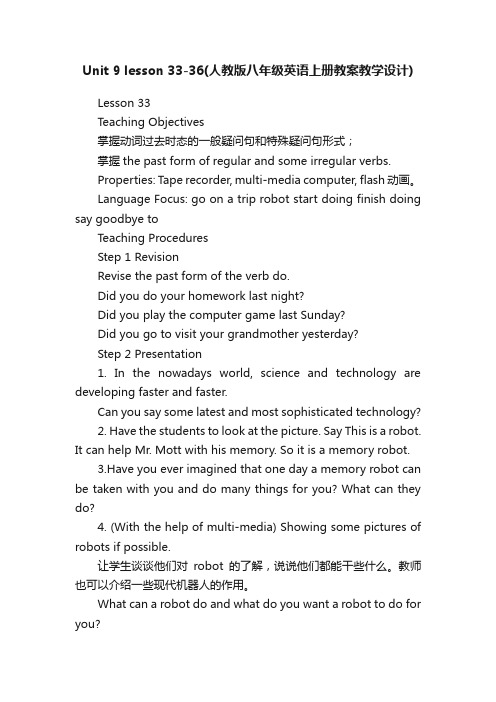
Unit 9 lesson 33-36(人教版八年级英语上册教案教学设计)Lesson 33Teaching Objectives掌握动词过去时态的一般疑问句和特殊疑问句形式;掌握the past form of regular and some irregular verbs.Properties: Tape recorder, multi-media computer, flash动画。
Language Focus: go on a trip robot start doing finish doing say goodbye toTeaching ProceduresStep 1 RevisionRevise the past form of the verb do.Did you do your homework last night?Did you play the computer game last Sunday?Did you go to visit your grandmother yesterday?Step 2 Presentation1. In the nowadays world, science and technology are developing faster and faster.Can you say some latest and most sophisticated technology?2. Have the students to look at the picture. Say This is a robot. It can help Mr. Mott with his memory. So it is a memory robot.3.Have you ever imagined that one day a memory robot can be taken with you and do many things for you? What can they do?4. (With the help of multi-media) Showing some pictures of robots if possible.让学生谈谈他们对robot的了解,说说他们都能干些什么。
- 1、下载文档前请自行甄别文档内容的完整性,平台不提供额外的编辑、内容补充、找答案等附加服务。
- 2、"仅部分预览"的文档,不可在线预览部分如存在完整性等问题,可反馈申请退款(可完整预览的文档不适用该条件!)。
- 3、如文档侵犯您的权益,请联系客服反馈,我们会尽快为您处理(人工客服工作时间:9:00-18:30)。
初二英语上册 lesson33的教学设计及反思一、教材分析1.教材的地位和作用:这一单元主要通过“谈论过去的经历”来继续学习一般过去时态的用法。
本节课在前一单元介绍 be动词的一般过去时态的表达法后,开始介绍实义v.的一般过去时态的用法。
与前一单元紧密联系,是它的延续。
2.教学目标:①.知识目标i.词汇:memory, pack, everything, umbrella, dry, newspaper, paper, morning paper, at breakfast, say goodbye to.ii.句型:did you……? 及其回答yes, i did. no, i didn't. when did you get up? what did you do……?iii.语法:学习实义v.的一般过去时态。
②.能力目标:使学生能初步运用一般过去时态谈论一些发生在过去的动作或经历。
③.德育目标:i.教育学生要有学科学,爱科学的精神。
ii.整堂课的设计要求学生具有竞争意识,参与意识和团结协作的精神。
iii.与教学内容相结合,教育学生节约用水。
3.教学重点与难点:①.教学重点:i.实义v.的过去式的变化。
ii.实义v.的一般过去时态,它的陈述句,疑问句及其应答,以及在具体情景中的交际运用。
②.教学难点:一般过去时态的实际运用。
二、教学方法与手段:主要运用了情景教学法和任务型教学法。
同时整堂课都串插竞赛机制,鼓励学生小组团结合作。
在尊重学生个性发展,面向全体学生的基础上,由浅入深,由已知到未知,循序渐进地深化教学内容。
展开以教师为主导,以学生为主体的师生双边活动。
另外,为了培养学生辨别、理解、分析、运用能力,教学中充分运用了多媒体辅助教学的手段,增强了教学的直观性和趣味性,加大了课堂密度,提高了教学效果。
三、教学设计:step 1.复习阶段:教学思路:1.首先以一首美丽轻快的英文儿歌带领学生进入课堂,以激发学生的学习爱好,营造轻松的英语学习氛围。
2.复习be动词的过去时态。
3.过渡到did you ….句型,开展男女竞赛,用这一句型造句,这样既复习了实义v. 也做到了以旧带新,为下一步做好铺垫。
(listen to an english song.)t: good morning, boys and girls.ss: good morning, miss zhu.t: how are you today?ss: fine, thank you.t: do you like the english song?s1: yes.t: where were you yesterday evening?s2: i was at home.t: did you listen to an english song?s2: no, i didn't.t: di d you watch tv/ play basketball/ …yesterday?s3: ……s4: ……s5: ……t: can you make sentences with “did you ……”?(get the ss to have a match between boys and girls. congratulations to the winners with a big handclap.)step 2. 导入阶段先告诉学生 i went on a trip last sunday.让学生用 did you 句型猜 where did i go ? what did i pack?这一步运用了猜谜和竞赛的方式,激起学生的好奇心,也再一次复习了 did you 句型用其回答,同时也为导入新课做好了预备。
接下去,由我的旅行引入 mr mott 的旅行。
教学过程:t:i went on a trip last sunday. where did i go, do you know?s1: did you go to beijing ?t: no, i didn't.s2: did you go to shanghai ?t: no, i didn't.s3: ……t: ……(show a picture on the screen.)t: i went to the west lake . and before i went there i packed a lot of things. ( write “pack” on the bb.) can you guess what i packed? if y ou can guess the right thing in the bag, you can get one star.s1: did you pack any apples?t: yes, i did. (show the real thing.)s2: did you pack any medicine?t: yes, i did. (show it.)s3: ……t: …… (write “newspaper, umbrella” on the bb.)t: i packed everything i needed in my bag.(write “everything” on the bb.)t: then i said goodbye to (with a gesture) my family. that day i had a lot of fun. today another person is going on a trip, too. do you know who he is? (show the picture of mr mott.)ss: mr mott.t: can you say something about mr mott?s1: he is very forgetful.t: yes. we can say he has a very bad memory.(write “memory” on the bb)who can help him? do you know?ss: his memory robot. (show the picture of the memory.)step 3. 操练阶段(part 1)教学思路:1.让学生带着问题边看录像边听对话,看录像可以增强直观性,引起学生的注重,也练习了听力。
2.跟读(教学dry时,联系实际,教育学生要节约用水。
)3.通过不同方式操练(全班练→小组练→两人对话。
)教学过程:t:now mr mott is at home with his wife and the robot. he is packing things for his trip. watch the video tape and try to find out the answer to the question.q: where is mr mott going to visit? what did he pack?(watch the video tape and then check the answers with the whole class.)t: now listen to the tape and repeat.(let the ss repeat each sentence after they hear it.)t: is beijing a very dry city?ss: yes.t: is yiwu a very dry city these years?ss: yes.t: so what should we do?s1: we should save water.t: good boy!( then get the ss to read the dialogue in groups of three. after that, call out two groups to act in front of the class.)(part 2)教学思路:1.以图片形式呈现 mr mott has a bad memory. so he keeps a diary every day. 2.听part 2. 录音,填表格,使学生了解part 2. 内容,也在具体的语言环境中理解了动词过去式的构成和含义,同时还练习了听力。
3.跟读对话。
4.学生自由操练。
5.列出对话中出现的v.原形和过去式。
跟读并快速记忆,然后让学生俩人小组比赛谁先说出v.的过去式。
通过这一步,让学生初步了解动词过去式的构成。
教学过程:(show a picture. mr mott is writing a diary.)t: we know mr mott has a bad memory. so he keeps a diary every day. what did he do today, do you know? now let's listen to the tape and fill in the form.(play the tape for the ss to listen, two times if necessary.)t: finished?ss: yes.t: ok. now let's check the answers.(ask the ss to show their answers one by one.)t: now let's listen to the tape again and repeat .(play the tape for the ss to listen and repeat. then get the ss to read the dialogue in groups. after that, call out two groups to act in front of the class.)timewhat did mr mott do ?(at 6:45 a.m. )got upbefore breakfast(went for a walk, bought a newspaper)(at breakfast)read the morning paperafter breakfast(mr and mrs turner came to see him)at 9:15 a.m.(started packing)(at 10:40 a.m. )finished packing(资料素材和资料部分来自网络,供参考。
